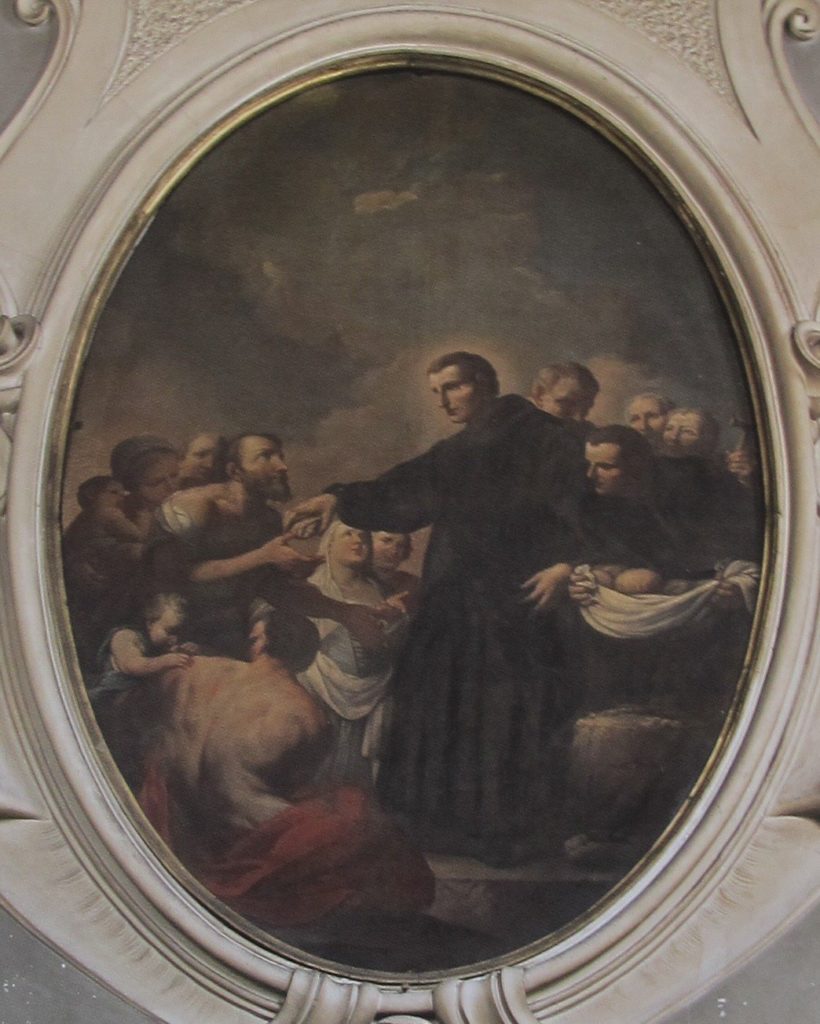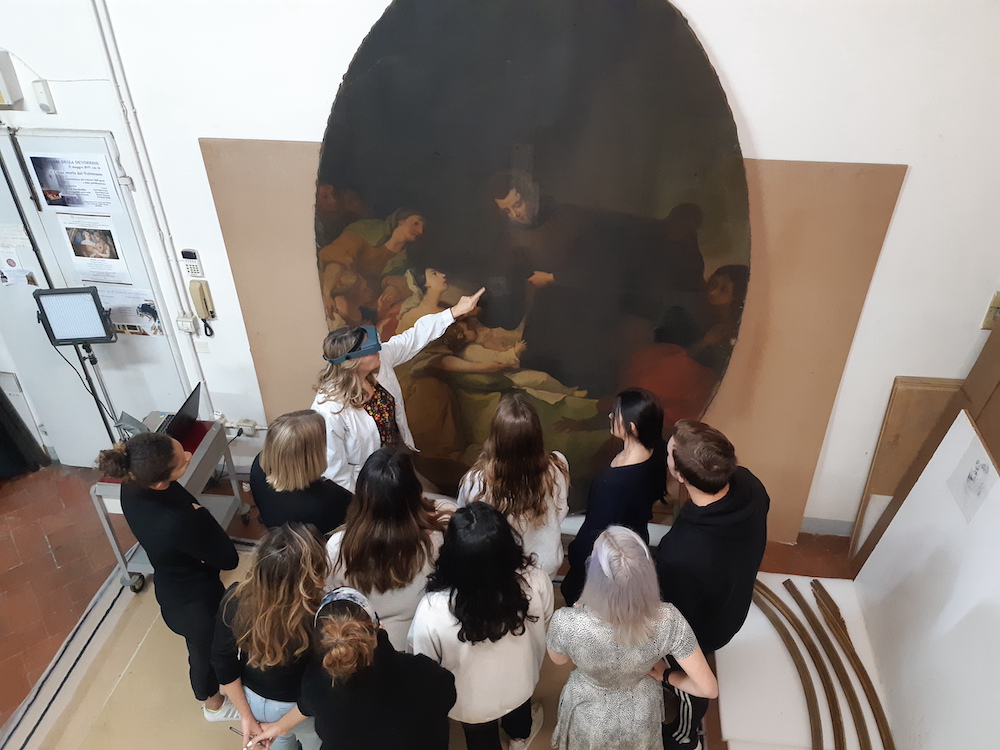Guest post by Ann Golob, Researcher, Advancing Women Artists
The eighteenth century was a time of tremendous change in Florence, Italy. Politically, the Medici era was coming to an end and the basic infrastructure of the city was in a state of decline. Florence—like all of Europe—was slowly recovering from the devastating loss of life during the era of the Black Plague and, by the 1740s, a new census revealed that the city’s population was finally beginning to grow. Then, with the death of the last Medici ruler, control was in the hands of the Habsburg dynasty, bringing uncertainty about how Florence would fare in this new order. This was also the era of the “Grand Tours,” when Europeans were traveling widely through Italy, Greece and beyond. Thousands came through Florence, bringing a renewed interest in its treasures despite the turmoil and change in political fortunes.
Women artists in the changing eighteenth century
For the overwhelming majority of women, life continued much as it had before—focused on home, marriage and children. But among the upper- and middle-classes, women were gaining entry to male domains in much greater numbers. Over the course of the eighteenth century, women were found throughout Europe hosting salons, writing books, and taking academic positions. Documents cited by Caroline Chapman in her 2017 book Eighteenth-century women artists: Their trials, tribulations and triumphs note that almost 300 women were working as professional artists, compared to fewer than ten throughout Europe in the fifteenth century. Further, she notes, between 1750 and 1770, six of the twenty most popular English novelists were female.
Writers of eighteenth-century travelogues often mentioned being intrigued by women in the intellectual and cultural life of the Italian cities. As historian Paula Findlen notes in Italy’s Eighteenth Century, this was still a novel idea to foreigners. In 1783 the Venetian playwright Pietro Chiari described his epoch as “The Century of Women,” and Findlen writes, “he captured the incessant fascination with educated, independent-minded, and socially unconventional women that characterized the eighteenth century.” But despite all this fascination with a few female successes, she concludes that it was, in the end, “a celebration of their uniqueness” and that “the fame of a few women painters did not make the arts a comfortable home for women aspiring to exercise their talents.”
Florentine artist Violante Ferroni
Perhaps it was the same for Violante Ferroni, a young Florentine artist. She proved able to ride the wave of fascination with women in the early years of her career, especially as a young ingenue with demonstrable talent. But in the end, she was unable to carve out a career in a world that still preferred only a limited number of exceptions to the rule of women remaining in the home. Or, perhaps not. Only further scholarship will allow art-lovers to know what Ferroni might have been able to achieve beyond her noteworthy works at the San Giovanni di Dio Hospital, in Florence.
In the mid-1700s, Ferroni was awarded a large and prestigious commission to complete two oval paintings, each 8 x 11.5 feet in dimension, for the atrium of a new wing of a building that would house the San Giovanni di Dio Hospital. One panel depicts Saint John of God ministering to plague victims. The other features Saint John giving bread to the poor.

by Violante Ferroni, 1756

by Violante Ferroni, post-1756
The building was once the home of the Vespucci family, and the birthplace of Amerigo Vespucci, for whom the Americas were named. At the time of Ferroni’s commission, it was being remodeled to enable the religious order of Saint John of God to care for the poor and the sick. The atrium was fitted with artworks by multiple painters and sculptors who worked in Florence at that time. Ferroni’s monumental works were installed at the top of the double staircase that adorned the main entry. A visitor to the hospital in the 1850s described how Mass was held in the atrium for “the convenience of the sick,” with the two Ferroni paintings as backdrop.

Despite the fact that female artists at this time typically painted small-scale devotional works or still-life pieces, Ferroni was selected to paint these large-scale ovals with traditionally “masculine” subjects: full-length figures and historic scenes with spiritual undertones. While early women artists occasionally broke out of the confines of what were considered minor genres, it was rare that a woman was able to create a career for herself from her artwork, especially if it meant competing in subject areas reserved for men.
Reconstructing Ferroni’s life
A few precious pieces of evidence help reconstruct the mosaic of Ferroni’s life and times. Baptismal rolls record Ferroni’s birth in 1720. Just 16 years later, she was listed as a painter in the accounting of the members of the Accademia delle Arti del Disegno. The Academy was the preeminent institution in Florence that operated as both school and professional guild. Admission was typically withheld until an artist was mid-career, rather than granted to teenagers. Four years later, Francesco Maria Niccolò Gabburri, the Florentine collector, art patron, scholar who headed the Academy from 1730 to 1740, included Ferroni in his compilation of short biographies of recently deceased and contemporary artists. He championed several women in his four-volume, handwritten manuscript—but few are as young as Ferroni, about whom he writes:
“Violante Ferroni, Florentine painter, pupil of Giovanni Domenico Ferretti. This witty and respectable young lady, after an in-depth and careful study of drawing, is now, in 1740, at the age of about 20, learning to paint portraits and historical scenes using oil paint and pastels. Her talent is most evident when she paints scenes of her own composition with oil paints, a medium in which she is also adept at colour mixing. So, Florence has reason to hope that she, in time, will get better and better at painting, especially because she is so enamoured of art that she never gets tired of improving her technique.“
As yet, we have not uncovered any records regarding the hospital commission, or any correspondence between the artist and the hospital representatives who hired her. There is documentation that the first of the two ovals was completed in 1756, when Ferroni was 36. The second followed sometime after, although the actual date is unknown. We know she continued to be a member of the Academy until 1762, so we can place her in Florence until at least then.
Though scant, information about the artist raises a significant question: how does a woman in Violante’s time show so much promise at such an early age, gain admission to the most prestigious art academy, merit an entry in the “Life of Artists” by Gabburri, win a large and prestigious commission in the heart of Florence—and yet become invisible to us today? Maybe the complexities of life led her to stop painting—an early death, the inability to continue painting due to illness, or perhaps she did not win any other major commissions. Maybe she left Florence and we have yet to uncover her work in other parts of Italy or Europe. There are many suppositions that can be made.
Resurrecting Violante Ferroni’s legacy
In 2019, the Florence-based US organization Advancing Women Artists (AWA) selected Ferroni’s two oval paintings for research and restoration. AWA has a history of selecting those women artists who “bent the rules” and these paintings fit that criterion.

and packaged for transit to restorer’s studio, October 2019
When the restoration, executed by conservators Elizabeth Wicks and Marina Vincenti, is completed, the paintings will be returned to public view at the San Giovanni di Dio Hospital location (today, the building houses The Council of a Right to Health and the Welfare and Sport Offices of the Tuscan region). Continued scholarship may uncover more about a young woman artist who seemed to take Florence by storm in the early 1700s.

Dr. Ann Golob is a research consultant working in the field of community and economic development. Presently she is in Florence, Italy contributing research to Advancing Women Artists.
Recent Art Herstory blog posts:
Exhibiting Women: The Art of Professionalism in London and Paris, 1760–1830, by Paris Spies-Gans
Mary Linwood’s Balancing Act, by Heidi A. Strobel
Anna Dorothea Therbusch: A Woman Painting Against Eighteenth-century Odds, by Stephanie Pearson
By Her Hand: Personal Thoughts and Reflections on an Exhibition, by Oliver Tostmann
Suor Orsola Maddalena Caccia (1596–1676), Convent Artist, Guest post by Dr. Angela Ghirardi
A Short Reintroduction to the Life of Anna Dorothea Therbusch (1721–1782), by Dr. Christina K. Lindeman
Rosalba Carriera at The Frick Collection, by Dr. Xavier F. Salomon
Angelica Kauffmann: Grace and Strength, Guest post by Dr. Anita V. Sganzerla
Artemisia Gentileschi: What Wasn’t in the London Exhibition and Why it Matters, Guest post by Dr. Jesse Locker
Elisabetta Sirani of Bologna (1638–1665), Guest post by Dr. Adelina Modesti
“I feel again the violence of a curious desire”: Rare client testimonies on Rosalba Carriera’s erotic art, Guest post by Dr. Angela Oberer
Two of a Kind: Giovanna Garzoni and Artemisia Gentileschi (Guest post by Dr. Mary D. Garrard)
Sister Caterina Vigri (St. Catherine of Bologna) and “Drawing for Devotion,” Guest post by Dr. Kathleen G. Arthur
Orsola Maddalena Caccia (1596-1676), Convent Artist, by Dr. Angela Ghirardi
A Tale of Two Women Painters (Guest post by Natasha Moura, reviewing the Prado exhibition of works by Sofonisba Anguissola and Lavinia Fontana)
The Protofeminist Insects of Giovanna Garzoni and Maria Sibylla Merian (Guest post by Prof. Emma Steinkraus)
For the complete list of Art Herstory blog posts, visit this link




